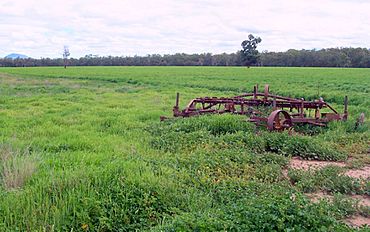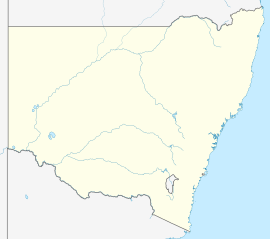Terry Hie Hie, New South Wales facts for kids
Quick facts for kids Terry Hie HieNew South Wales |
|||||||||||||||
|---|---|---|---|---|---|---|---|---|---|---|---|---|---|---|---|

Agricultural land at Terry Hie Hie
|
|||||||||||||||
| Postcode(s) | 2400 | ||||||||||||||
| Elevation | 266 m (873 ft) | ||||||||||||||
| Location | |||||||||||||||
| LGA(s) | Moree Plains | ||||||||||||||
| State electorate(s) | Northern Tablelands | ||||||||||||||
| Federal Division(s) | Parkes | ||||||||||||||
|
|||||||||||||||
Terry Hie Hie is a small farming town in northern New South Wales, Australia. It is located within the Moree Plains Shire Council area. You can find Terry Hie Hie south of the Gwydir Highway and east of the Newell Highway. The closest big town is Moree, about 47 kilometers to the south-east.
Contents
Terry Hie Hie's Location and Environment
Terry Hie Hie is a quiet place known for its farming. The town is surrounded by agricultural land, which means people grow crops and raise animals there.
Tycannah Creek and Flooding
The Tycannah Creek flows right through Terry Hie Hie. Sometimes, when there is a lot of rain, the creek can flood. This means the water rises and can cover parts of the town, including some houses. For example, in November 2011 and February 2012, the creek flooded. During the February 2012 flood, 12 people had to leave their homes for safety because of heavy rain in the creek's area.
Protecting Local Land and Culture
Terry Hie Hie is important to local Aboriginal groups. They, along with conservationists, have been working to protect a large area of land nearby.
Plans for a National Park
As recently as 2005, there were plans to create a 160 square kilometer national park in the area. A national park is a special place protected by the government to keep nature safe. This proposed park would include seven existing State forests and one nature reserve.
Importance to Aboriginal People
For the local Aboriginal people, this land is very special. They see it as "the last big bit of bush that Aboriginal people can connect with in the Moree area." This means it's a place where they can feel connected to their history and culture. Because of its importance, logging (cutting down trees) stopped in the Mission State Forest in 2004.


